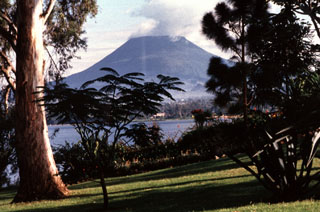Report on Nyiragongo (DR Congo) — February 1977
Natural Science Event Bulletin, vol. 2, no. 2 (February 1977)
Managing Editor: David Squires.
Nyiragongo (DR Congo) Additional details about 10 January fissure eruption
Please cite this report as:
Global Volcanism Program, 1977. Report on Nyiragongo (DR Congo) (Squires, D., ed.). Natural Science Event Bulletin, 2:2. Smithsonian Institution. https://doi.org/10.5479/si.GVP.NSEB197702-223030
Nyiragongo
DR Congo
1.52°S, 29.25°E; summit elev. 3470 m
All times are local (unless otherwise noted)
Activity at Nyiragongo began in early December 1976, when the lava lake rose and covered half of the first platform. Premonitory seismic activity was noted from December 11 (see above description of Nyamuragira activity, 14 km NW of Nyiragongo). The eruption began from five fissure vents at about 2,200 m elevation on the SE flank. Four lava flows were extruded, to the S, SE, SW, and NE. The latter flow blocked a major road, preventing supplies from reaching the area. About 100-150 hectares of land and 400 houses were destroyed by the flows. Estimates of deaths range from 38-60.
Geological Summary. The Nyiragongo stratovolcano contained a lava lake in its deep summit crater that was active for half a century before draining catastrophically through its outer flanks in 1977. The steep slopes contrast to the low profile of its neighboring shield volcano, Nyamuragira. Benches in the steep-walled, 1.2-km-wide summit crater mark levels of former lava lakes, which have been observed since the late-19th century. Two older stratovolcanoes, Baruta and Shaheru, are partially overlapped by Nyiragongo on the north and south. About 100 cones are located primarily along radial fissures south of Shaheru, east of the summit, and along a NE-SW zone extending as far as Lake Kivu. Many cones are buried by voluminous lava flows that extend long distances down the flanks, which is characterized by the eruption of foiditic rocks. The extremely fluid 1977 lava flows caused many fatalities, as did lava flows that inundated portions of the major city of Goma in January 2002.
Information Contacts: U.S. Dept. of State; S. Ueki, IRS.

